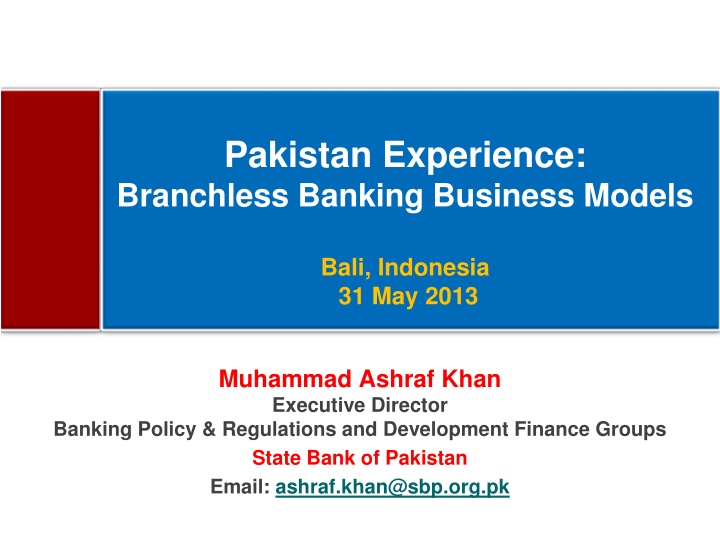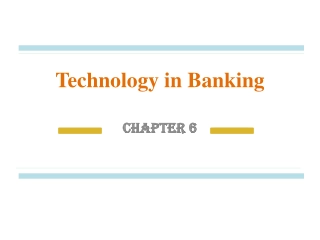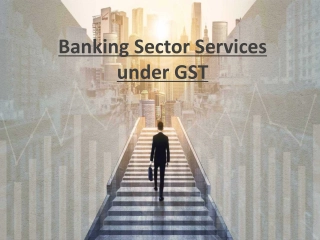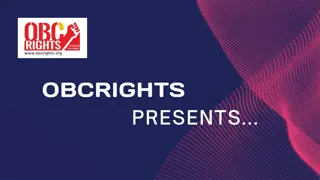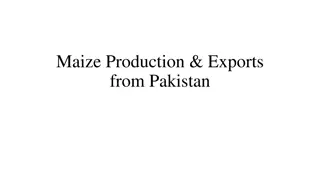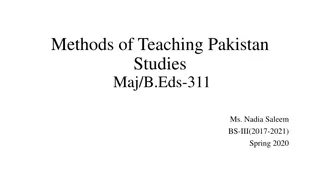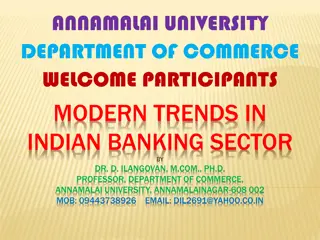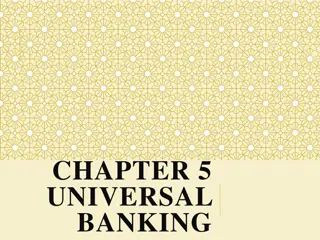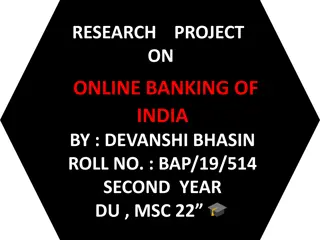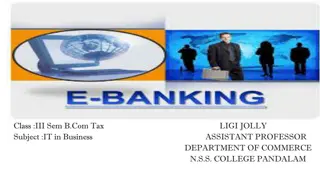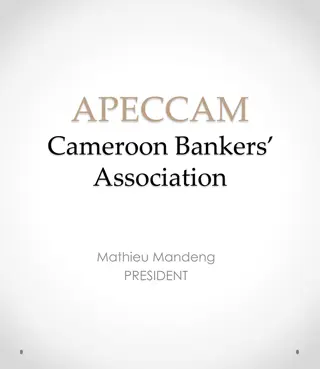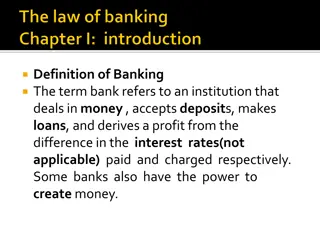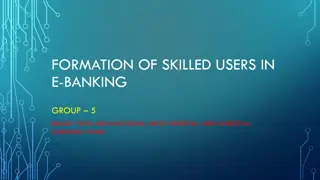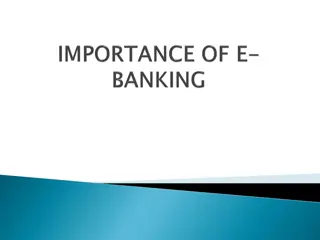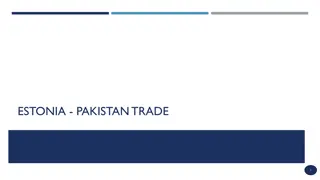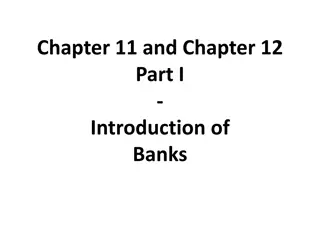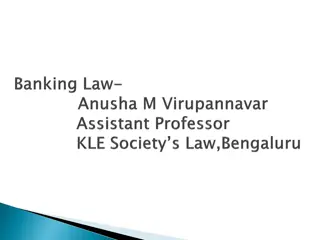Branchless Banking Regulatory Objectives in Pakistan
State Bank of Pakistan's Executive Director, Muhammad Ashraf Khan, discusses the regulatory objectives, key growth indicators, challenges, and the way forward for branchless banking in Pakistan. This presentation outlines the need for branchless banking, the state of financial inclusion in the country, and the favorable composition for its successful implementation. It further delves into the regulatory framework, SBP's branchless banking regulations, and the benefits of a bank-led approach for digital financial inclusion.
Download Presentation

Please find below an Image/Link to download the presentation.
The content on the website is provided AS IS for your information and personal use only. It may not be sold, licensed, or shared on other websites without obtaining consent from the author.If you encounter any issues during the download, it is possible that the publisher has removed the file from their server.
You are allowed to download the files provided on this website for personal or commercial use, subject to the condition that they are used lawfully. All files are the property of their respective owners.
The content on the website is provided AS IS for your information and personal use only. It may not be sold, licensed, or shared on other websites without obtaining consent from the author.
E N D
Presentation Transcript
Pakistan Experience: Branchless Banking Business Models Bali, Indonesia 31 May 2013 Muhammad Ashraf Khan Executive Director Banking Policy & Regulations and Development Finance Groups State Bank of Pakistan Email: ashraf.khan@sbp.org.pk
Presentation Outline Why Branchless Banking Regulatory Objectives for Branchless Banking Branchless Banking Regulations Key Growth Indicators Key Policy Initiatives, Challenges & Way Forward 2
Why BB? State of Financial Inclusion in Pakistan Adult Population (> 15 years) Rural Urban 120 million 60% 40% Bank Branches Rural Urban 11000 30% 70% Total accounts Financial access* 35.5 million 12% of adult population * As per Access to Finance Survey - 2008, 88% do not have access to formal financial services 3
Why BB? Favorable Composition in Pakistan Competitive Banking Sector Branches network and assets are fairly distributed across different banks o Robust Payment System (1-Link & M-Net) and RTGS o Regulations, Disclosures, & Consumer Protection o Competitive Telecom Industry Five MNOs with substantial fragmentation o High mobile phone subscription ( >120 Million ) & usage o Extensive distribution network o Wide geographic presence o High Capital Investment in IT Infrastructure o Financial Inclusion Building a strong case Huge untapped Market o Market insight & experiences o Microfinance attracting strong investors - Banking and Telecom Industry o 4
Regulatory Objectives: Branchless Banking Bank-led approach Licensed and regulated by SBP Mobile being banking account. Convenient for customers Safety, security and soundness of technology and agents. Risk-based KYC and other AML requirements Developing & maintaining public confidence Digital Financial Inclusion 5
Overview Branchless Banking Regulations 6
Branchless Banking Regulations: SBP introduced BB Regulations initially in March 2008 Regulatory Revision in June 2011 Flexibility of Models Provision of basic BB Services Tiered BB Accounts Transaction Limits Agent Structure Agent due diligence Technology Risks Consumer Protection Licensing for pilot and commercial launch 7 Annual approval for agents expansion
Flexibility of Models One bank one telco Great customization Good service standards Co-branding / Co-marketing Limited outreach One-to-one (1-1) One bank Many telcos Great outreach Telco readiness issue Advertising/Marketing on bank s expense One-to-many (1- ) Many banks many telcos Maximum outreach Settlement issues Many-to- many ( - ) 8
Exploring Other possibilities Alternative Channels Fuel distribution companies, chain stores, Pakistan Post, retailers etc. using technologies like mobile phone, GPRS, POS terminals etc 9
Branchless Banking Services Account Opening Loan Payment Cash In BB Products Loan Disburse- ment Cash Out Bills Payment Funds Transfer 10
Levels of BB Accounts: Account Level Level 0 Level 1 Basic account for individuals Entry Level for individuals . Description establish identity through copy of CNIC & digital photo, verification required opened at agent locations Risk based KYC Requirement USD 150 per day USD 250 per month USD 1,200 per year USD 250 per day USD 600 per month USD 5,000 per year Transaction Limits Max. Balance USD 1,000 No Limit USD 1 = Rs. 100 11
Levels of BB Accounts: Account Level Level 2 Level 3 For merchants, businesses, banking agents, technology service providers and corporations. For individuals as well as businesses Description KYC Regular KYC / CDD and AML requirements Accounts can only be opened at bank branches requirements Transaction Limits Bank set s transaction limits 12
Fund Transfers (OTC): Account-to-Person Person-to-Person Fund Transfers by BB account holder to other persons (CNIC) Person-to-Person fund transfers Description KYC Customers to be registered by the bank for transactions. requirements Transaction Limits USD 250 per month USD 150 per month 13
Agent assisted banking Roles & responsibilities of Agents Facilitation of opening of BB Accounts Activities allowed in BBRs Agent Structure Super Agent Direct Agent Sub Agent. Agent Due Diligence Service Level Agreement Agent Development New Agent Take on Policy 14
Managing Risk and Protecting Consumers Risk Management Program Banks to identify likely business risks Specific agent related risks Management of agent related risks Wireless/ e-Banking Technology Risks Consumer Protection Banks to develop policy on: Protection Awareness Complaint Redressal Mechanism 15
Key Branchless Banking Indicators Indicators Oct-Dec Qtr, 2012 Total No. of Agents 41,567 Total No. of Accounts 2.1 millions Total Deposits as of Date USD 10 millions No. of Transactions During the Quarter 35.3 millions Value of Transactions During the Quarter USD 1,500 millions Average Size of Transaction in USD USD 42 Average No. of Transaction Per Day 392,433 17
Major Growth Indicators - Trends No. of BB agents No. of BB accounts (In '000') 41,567 45,000 40,000 2,500 2,112 35,000 29,525 30,540 2,000 26,792 30,000 1,761 22,512 25,000 1,447 1,500 15,729 17,588 19,402 20,000 1,060 929 15,000 1,000 665 10,000 439 347 5,000 500 - - Q1 2011 Q2 2011 Q3 2011 Q4 2011 Q1 2012 Q2 2012 Q3 2012 Q4 2012 Q1 2011Q2 2011Q3 2011Q4 2011Q1 2012Q2 2012Q3 2012Q4 2012 Value of Transactions (USD in million) No. of transactions (in 000') 1,800 1,526 40,000 1,600 35,319 1,422 31,893 35,000 1,400 1,165 28,366 30,000 1,200 25,272 25,000 860 1,000 20,597 802 20,000 800 15,867 593 12,500 15,000 600 414 9,056 318 10,000 400 200 5,000 - - Q1 2011Q2 2011Q3 2011Q4 2011Q1 2012Q2 2012Q3 2012Q4 2012 Q1 2011 Q2 2011 Q3 2011 Q4 2011 Q1 2012 Q2 2012 Q3 2012 Q4 2012 18
Diversity in BB transactions Remittances o Domestic remittance o International remittance Bills payment and mobile top-ups Government to person payments o Welfare payments to poor / low income groups (BISP cards) o Calamity-hit population (Watan/IDPs Cards) o Pension payments (EOBI pensioners) o Salaries payments M-wallets registration and usage o MW to MW transfers o Savings o Insurance Micro-loans installments/repayments Airline ticketing Dairy value chain payments (Cash collection/payment services to ENGRO food) 19
Demand side Insights indicates a long journey ahead 5% Pakistani households have a mobile money user. (Kenya: 86%, Tanzania: 35%, and Uganda: 21%) Only 1% of all payments were channeled through mobile money system 0.3% have registered mobile money accounts. 95% of mobile money users are male and only 5% are female 59% of OTC users did not see the need to open an account Only 60% even know mobile money exist Source: Gates Foundation s Financial Inclusion Tracking Survey in Pakistan 20
Countries Relative Strength of the Institutional and Market Environment The Mobile Financial Services Development Report 2011
Policy Initiatives Formation of BB consultative group Working groups on 1) Agent development 2) Code of Ethics 3) customer education & protection SBP-PTA team developing Interoperability Framework Consultative approach Branchless Banking Newsletter Sectoral Diagnostic Study Analytics & Disclosure Surveys to assess agents/clients related issues Develop capacity building Exposure visit programs Research /Surveys Consumer Education First-ever Nationwide Financial Literacy Program (NFLP) DFID-funded GBP 10 million Financial Innovation Challenge Fund G2Ps projects Innovation Fund SBP Policy approach has been globally acknowledged. 22
Key Challenges Agent Development: Agents profiling & development Building agents business case Enabling agents to register M-wallets/Accounts Agents monitoring & evaluation o o o o Market Competition: Sharing of agents Price/Commission War o o Products: Creating value proposition for m-wallets Linking loan disbursements & collections Developing suite of financial services (insurance, G2Ps, digital bonds etc.) o o o Customers awareness: 23
Way Forward Building mobile banking ecosystem: Expansion in cash-handling infrastructure (ATMs, PoS etc) Integrating branchless banking accounts with conventional banking accounts through 1-link Utility Bills aggregators G2P Payments Establish Agent Bureau o o o o o Moving from OTC to account based services SBP-PTA Joint Regulatory Committee on interoperability Working on initiatives such as consumer education programs, researches, trainings, policy papers etc. Deepening linkages with global partners 24
